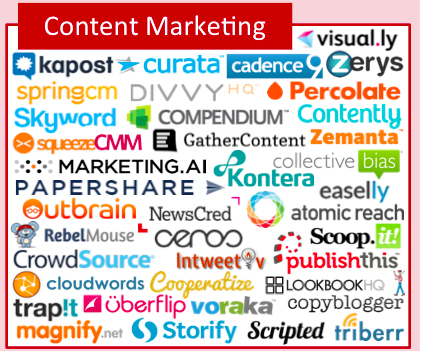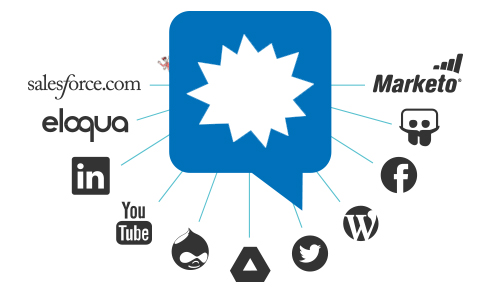Over 90% of all the data in the entire world has been generated in the past two years.
That should be both terrifying and exciting to marketers. With more information on prospective buyers, you can better tailor the message. But you’re also up against a growing number of competitive content all vying for those buyers’ attention.
Data includes the billions of blog posts, emails, tweets, texts and other communications we all interact with. More information has meant more to keep up with.
Thankfully, new technology has developed to help track and organize marketing…

I found Kapost’s logo, but only because I was really good at “Where’s Waldo?” as a child.
…unfortunately, now we need a technology to help track and organize all the new tech.
Even looking more closely at one of the sub sectors on that grid from Scott Brinker is dizzying.

It’s hard enough for marketers to adequately explain their needs, let alone identify solutions. But I’m going to try to help content marketers match needs with the right technology.
There’s a lot of logos in that box above. Many tools fall under the “content marketing software” umbrella. Not all of them are alike. Knowing which goals or challenges you’re trying to meet is critical to selecting the right tool.
But what if you don’t know what you need?

Volume
One of the biggest challenges marketers face is producing enough content. As a result, they’ll often rely on curation, selecting a solution for sourcing third-party content.
But curation is not a content marketing strategy. It’s a tactic.
And it’s a great tactic too, when combined with original, internally-produced content. The backbone of a robust content marketing strategy is content that’s been produced by your people, addressing the key issues, pains and desires of your buyers.
That’s not to say freelance talent and curated content doesn’t play a role. But it’s a supporting role, strengthening the messaging your team has meticulously crafted.
“Curation is not a content strategy. It’s a tactic.” – @andrewjcoate
So your goal shouldn’t be to find a tool that only makes outsourcing content easier, but allows you to manage all three pieces (curation, outsourcing, unique content) together into a coherent strategy. If volume is a key goal, consider platforms that allow you manage internal and external contributors and integrates with curation tools.
Organization
There are two sides to organizing content: organizing the creation, distribution, promotion and performance of the content itself, and organizing those who will create that content. This is why a strong workflow management process is crucial.
The software you choose should not only provide a higher-level view of the content being produced and producers, but the ability to set defined process steps and to collaborate from the idea stage to distribution to reporting.
These are not issues that can be solved with a Google Calendar and some online documents. They don’t allow a simple, unified view of what’s happening, where in the creation process pieces are and who’s responsible for the next steps – all strengths of solid content marketing software.
Integration
As the chart above demonstrates, marketers are relying on an expanding assortment of tools to solve an even larger number of issues. Since most organizations don’t want to be pushed into using one tool that does one thing well and another poorly, it’s invaluable that whatever solution you choose plays well with others.

Your Content Marketing Software should be like this. Only, probably less menacing.
When it comes to content marketing software, the platform should integrate with the critical marketing functions. This list would include Marketing Automation, Customer Relationship Management (CRM), and Social Media Management platforms. Ideally it would also connect seamlessly with a variety of distribution channels like social media networks (such as Twitter and SlideShare), webinar platforms (like ReadyTalk), or Content Management Systems (like Drupal or WordPress).

Oh, there’s Waldo!
If you relate to any of the needs I’ve outlined, consider asking this question when examining content marketing software — “Will this tool let me organize and create the widest variety of content while syncing with the widest variety of other tools?”
Need further help evaluating content marketing software? Download the An Introduction to Content Marketing Software eBook or post any questions you have in the comments section below.

